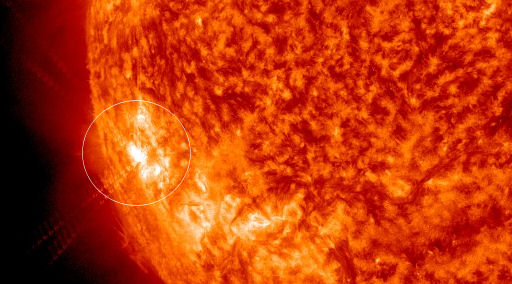CHANCE OF MAGNETIC STORMS: NOAA forecasters estimate a 30% chance of polar geomagnetic storms during the next 48 hours as a pair of CMEs pass by Earth, possibly delivering glancing blows to our magnetic field. Magnetic storm alerts: text, voice.
TRIPLE FLYBY: As the solstice approaches on June 20th, the International Space Station is spending some extra time in the sun. Ironically, this means you're more likely to see it in the night sky. Mark Humpage photographed three ISS flybys over his home in Lutterworth UK on June 10th:
"There were actually four flybys this evening at 2207, 2343, 0119 and 0256 hrs, however, the first was clouded out," says Humpage. "I added a few bursts of flash just before the first flyby to light up the garden and then left the camera running all night. The following morning I extracted all the images and stacked them to produce the final composite."
Readers, now is a great time to look for the behemoth spacecraft glistening in sunlight among the stars. Flyby times are available on your smartphone or from Space Weather's Simple Satellite Tracker.
M-FLARES: New sunspot AR1504 is crackling with impulsive M-class solar flares. NASA's Solar Dynamics Observatory photographed the extreme UV flash from one of them, an M2-class flare on June 10th at 0645 UT:
So far none of the blasts has been Earth directed, but geoeffective eruptions are possible in the days ahead as AR1504 turns toward Earth. NOAA forecasters estimate a 55% chance of more M-flares today. Stay tuned.Solar flare alerts: text,

![]()
Solar wind
speed: 394.2 km/sec
density: 2.8 protons/cm3
explanation | more data
Updated: Today at 1506 UT
![]()
X-ray Solar Flares
6-hr max: C1 1129 UT Jun11
24-hr: C1 1129 UT Jun11
explanation | more data
Updated: Today at: 1500 UT
![]()
![]()
![]()
Daily Sun: 11 Jun 12
![]()
![]()
Sunspot 1504 is crackling with impulsive M-class solar flares. Credit: SDO/HMI
![]()
![]()
![]()
Sunspot number: 127
What is the sunspot number?
Updated 10 Jun 2012
Spotless Days
Current Stretch: 0 days
2012 total: 0 days (0%)
2011 total: 2 days (<1%)
2010 total: 51 days (14%)
2009 total: 260 days (71%)
Since 2004: 821 days
Typical Solar Min: 486 days
Updated 10 Jun 2012
The Radio Sun
10.7 cm flux: 128 sfu
explanation | more data
Updated 10 Jun 2012
![]()
![]()
![]()
Current Auroral Oval:
![]()
Switch to: Europe, USA, New Zealand, Antarctica
Credit: NOAA/POES
![]()
![]()
![]()
Planetary K-index
Now: Kp= 2 quiet
24-hr max: Kp= 3 quiet
explanation | more data
![]()
Interplanetary Mag. Field
Btotal: 6.6 nT
Bz: 0.1 nT south
explanation | more data
Updated: Today at 1506 UT
![]()
![]()
![]()
Coronal Holes: 11 Jun 12
![]()
![]()
There are no large coronal holes on the Earthside of the sun. Credit: SDO/AIA






